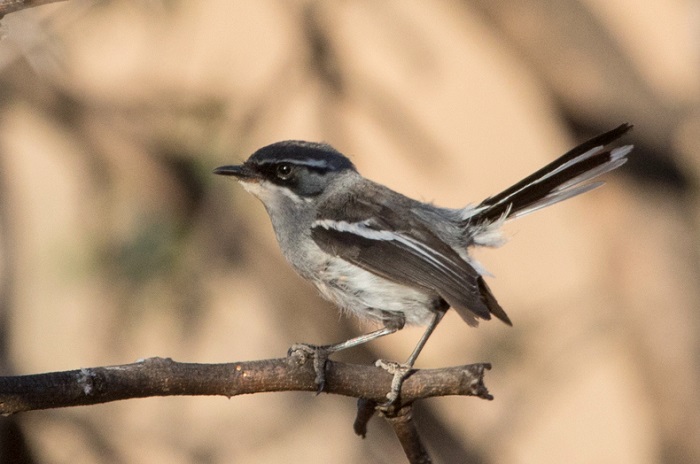Cover image: Fairy Flycatcher by Marna Buys – Wonderboom, Gauteng – BirdPix No. 261347
Identification
This species is notable for being one of the smallest birds in southern Africa, weighing in at just 6 grams.

Middelburg district, Eastern Cape
Photo by Tino Herselman
The Fairy Flycatcher has distinctive grey, black and white plumage. The head is grey with a black facial mask, surrounded by white. The mantle and back are plain grey, and the breast and upper belly is grey, fading to white with a slight peach-coloured wash on the flanks and lower belly. The flight feathers are black with a conspicuous white wing bar. The tail is black and fairly long with white outer tail feathers.
The sexes are alike, while juveniles are browner above and lack the peach flanks.
The Fairy Flycatcher is perhaps most likely to be mistaken for the black, white and grey male of the Pririt Batis (Batis pririt), but that species has a distinctive, broad black breast-band and a shorter tail.

Standerton, Mpumalanga
Photo by JC van Rensburg
Status and Distribution
The Fairy Flycatcher is fairly common to common and is endemic to southern Africa. Its range encompasses most of South Africa, but is mostly absent from hot low lying areas like the lowveld and Zululand. Its range also excludes a broad coastal strip from near East London in the Eastern Cape to northern KwaZulu-Natal.
The range includes all of Lesotho and just reaches into Eswatini (Swaziland). It also occurs during winter in southern Namibia, south-eastern Botswana and very marginally in Zimbabwe.

Details for map interpretation can be found here.
The Fairy Flycatcher is most numerous in the Nama Karoo where it is resident, moving into surrounding biomes as an altitudinal migrant during the winter months.
There is no evidence of changes to its distribution, and the Fairy Flycatcher is not considered threatened.

Near Anysberg, Western Cape
Photo by Sue Gie
Habitat
The Fairy Flycatcher prefers semi-arid Karoo shrublands, of both the Nama and Succulent Karoo. It also inhabits fynbos and grassland regions. It requires an element of woody growth, however sparse, in which to forage, such as thorny thickets, scrubby mountain kloofs, wooded hillsides and drainage lines.
It is mostly resident in the Nama and Succulent Karoo biomes, moving into Acacia savanna, montane scrub, fynbos, plantations and gardens, particularly in the northern and eastern parts of its distribution. The Fairy Flycatcher normally avoids extensive closed woodlands.

Photo by Ryan Tippett
Behaviour
The Fairy Flycatcher is an active species that moves around singly, in pairs or occasionally in loose family groups. Restless, agile and constantly on the move, the Fairy Flycatcher forages among foliage, flitting between trees and shrubs. It frequently fans and raises its tail. Flies low from bush to bush and seldom flies far.

Hillston Farm, Eastern Cape
Photo by David Solomon
Fairy Flycatchers join mixed-species foraging parties with other small insectivorous species. Gleans small prey from twigs and leaves and flowers within leafy bushes, or in tree canopies. Often hawks airborne insects in short, fluttering flights. The Fairy Flycatcher’s dies consists entirely of small invertebrates, including flies mosquitoes, Hemiptera (Bugs), very small beetles, lacewings, wasps, moths and spiders.

Soutpan district, Free State
Photo by Toby Esplin
The Fairy Flycatcher breeds from October to December. It is a monogamous, solitary nester. The nest is a small, deep cup of finely shredded grass, weed stems and shredded bark, bound with spider web and is built entirely by the female. The outside of the nest is camouflaged with a layer of lichen, strands of bark and dry foliage secured with spider web to the outer wall. The nest is well hidden and usually placed in a densely foliaged shrub around 1m above the ground.

Sani Pass, KwaZulu-Natal
Photo by Dave Rimmer
2 or 3 glossy, pale green-brown eggs are laid per clutch. The incubation period lasts from 17 to 18 days and all incubation is likely performed by the female. The male feeds the female in the nest. The young are altricial but further details regarding the nestling period etc. are unrecorded.
Further Resources
Species text adapted from the first Southern African Bird Atlas Project (SABAP1), 1997.
The use of photographs by Dave Rimmer, David Solomon, JC van Rensburg, Lance Robinson, Marna Buys, Sue Gie, Tino Herselman and Toby Esplin is acknowledged.
Virtual Museum (BirdPix > Search VM > By Scientific or Common Name).
Other common names: Fairy Warbler (Alt. English); Feevlieëvanger (Afrikaans); Mignard enchanteur, Érythrocerque de Livingstone (French); Elf-apalis (Dutch); Livingstones Rotschwanzschnäpper (German); Papa-moscas-d’asa-branca (Portuguese).
List of bird species in this format is available here.
Recommended citation format: Tippett RM 2023. Fairy Flycatcher Stenostira scita. Biodiversity and Development Institute. Available online at https://thebdi.org/2024/01/22/fairy-flycatcher-stenostira-scita/

Klipriviersberg Nature Reserve, Gauteng
Photo by Lance Robinson

